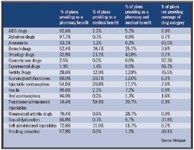Coverage for specific drug classes
Over the next few years, more health plans and employers will investigate covering the physician-administered injectable drugs under the pharmacy benefit as a way to control the costs and manage appropriate utilization, says Kathryn Lindhorst Canaday, PharmD, director of pharmacy analysis, Pharmaceutical Strategies Group (PSG), based in Dallas.

"Employers will begin to ask their health plans to demonstrate that the pricing for the drugs under the medical benefit is equivalent to the pricing they can receive under the pharmacy benefit through their PBM. If it is not equivalent, then the employers will require the injectable drugs to come under their pharmacy program," Dr. Canaday says.
According to her, implementing prior authorization, step therapy or quantity limits are done more easily in the pharmacy system than in the medical system.
EXCEPTION TO THE GENERAL RULE
There is however, an exception, namely, mixing the medical and pharmacy benefits. Dr. Canaday observes that the member copayment or coinsurance is the biggest difference between pharmacy and medical benefit. "In the past, there hasn't been any copayment or coinsurance on drugs administered in a physician's office," she says. "But this is changing as payers face increased costs from specialty drugs."
Blending of medical and pharmacy data, says Haynes, has allowed better outcomes measures by looking at the total healthcare spend. "However, carving out the pharmacy benefit, too, has its advantages, such as allowing for tighter drug therapy controls," he says. Tighter control can mean more in-depth knowledge of specific data elements such as drug, dose, strength, day supply, etc., that is captured when the drugs are processed through the pharmacy benefit administrator.
Another advantage of processing these medications through the pharmacy benefit is that the systems are in place to capture and identify potential drug-drug interactions and drug-disease contraindications. "The data and reporting capabilities are also an advantage of the pharmacy benefit when compared with the medical benefit," Haynes says. "One can track and trend the drug spend more accurately and in a more timely fashion."
But, drug spend should not be the sole focus. "Managing overall healthcare spend is the ultimate goal for any MCO," Haynes says. "Without improved patient outcomes as a result of effective drug therapy, significant medical and pharmacy resources are at risk, not only in cost but ultimately in patient care. There is no one single solution . . . Organizationally-specific variables ultimately must drive decision-making processes."
-Tracey WalkerCommentary is independent of source data
Exclusive content ONLINE For more on specific drug classes, visit http://www.managedhealthcareexecutive.com/
David Calabrese of OptumRx Talks New Role, Market Insulin Prices and Other Topics 'On His Mind'
April 13th 2023In this month’s episode of the "What's On Your Mind podcast," Peter Wehrwein, managing editor of MHE connects with the now Chief Clinical Officer of OptumRx Integrated Pharmacies, David Calabrese. In this conversation, David touches on his transition in January as OptumRx’s former chief pharmacy officer and market president of health plans and PBMs to his new role as Chief Clinical Officer where he now focuses more on things such as specialty pharmacy to home delivery — with an overall goal of creating whole-patient care. Throughout the conversation, Calabrese also touched on the market’s hot topic of insulin prices and behavioral health services within the OptumRx community, among other topics.
Listen
Briana Contreras, editor of Managed Healthcare Executive, spoke with Nancy Lurker, CEO and president of EyePoint Pharmaceuticals. Nancy shared a bit about EyePoint and how the organization’s innovative therapies are addressing patient needs through eye care, and most importantly, she addressed C-Suite positions like the CEO role. Nancy shared advice for those seeking to reach the CEO level, especially toward women in healthcare and other roles, and what it takes to run a biopharma company.
Listen
Upended: Can PBM Transparency Succeed?
March 6th 2024Simmering tensions in the pharmacy benefit management (PBM) industry have turned into fault lines. The PBMs challenging the "big three" have formed a trade association. Purchaser coalitions want change. The head of the industry's trade group says inherent marketplace friction has spilled over into political friction.
Read More
Florida Gets the OK. But Will Drug Importation from Canada Actually Happen?
March 5th 2024Canadian health officials warn that maintaining a drug supply for Canadians is their priority. The staunch opposition of the U.S. pharmaceutical industry may also be an obstacle to imports from north of the border.
Read More